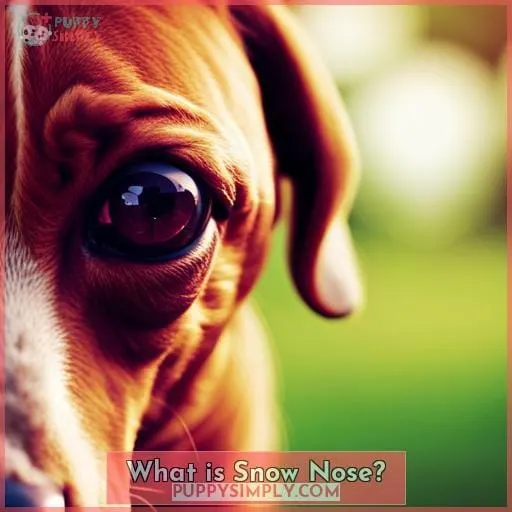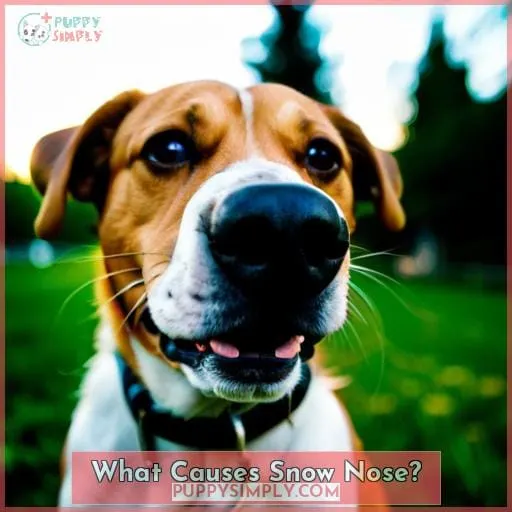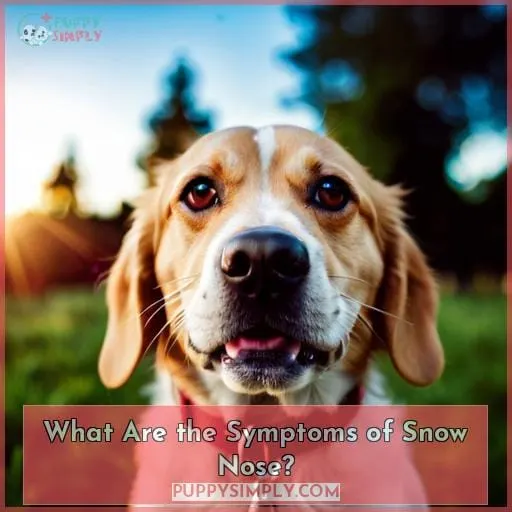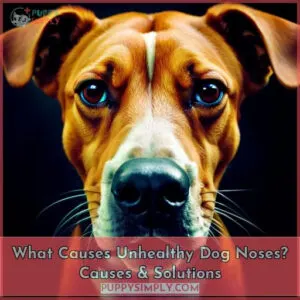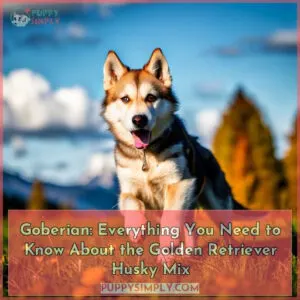This site is supported by our readers. We may earn a commission, at no cost to you, if you purchase through links.
Do you have a dog with a pink spot on their nose? You’re not alone. Snow Nose, or Hypopigmentation, is an increasingly common condition among dogs that causes their noses to lighten in color from black/brown into shades of pink and brown.
It’s usually nothing to worry about but can cause some problems if left untreated.
Table Of Contents
Key Takeaways
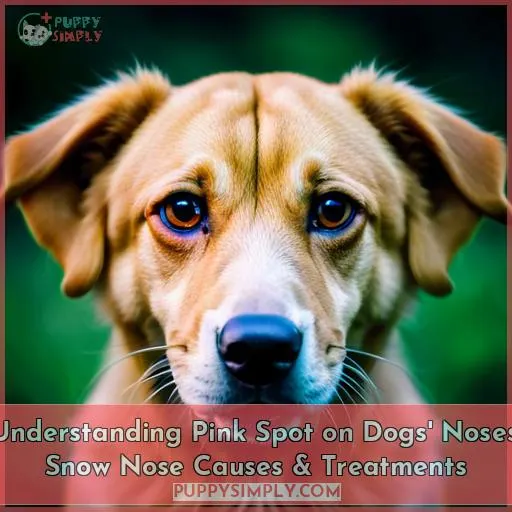
- A pink spot on a dog’s nose may be a sign of snow nose, a common condition that causes the nose to lighten in color.
- Snow nose is more common in winter or during cold climates, so the pink spot may be temporary, and the color of the nose may return to normal once temperatures warm up.
- It is important to monitor any changes in pigment, texture, or moisture on the dog’s nose and consult a vet if there are concerns.
- Snow nose is generally not a serious health concern, but it is important to take steps to protect the dog’s nose from sun damage and to seek medical examination if there are sores or other signs of a more serious issue.
What is Snow Nose?
You may have noticed that some dogs develop a lighter nose in the winter or during cold climates – this is known as Snow Nose, and it affects around 30% of all breeds. Dr. Cain explains that snow nose is caused by a breakdown of an enzyme that produces melanin, protecting your dog’s noses from sun damage.
This protective layer can be lost in colder climates and cause their noses to lighten up significantly. However, there are ways you can help protect your pup’s precious snout! Limiting exposure to direct sunlight when possible and using pet-friendly sunscreen on walks should help keep their noses safe from harm.
Additionally, switching out plastic bowls for metal or ceramic ones may also assist with pigment restoration if needed. Dr. Koch recommends checking with your vet first regardless! Sudden changes in color should always be reported so health issues can be ruled out before concluding nothing else is wrong with them too – especially since snow nose does not typically require treatment other than time passing by for the color to return back naturally once temperatures warm up again soon enough.
What Causes Snow Nose?
Snow nose, also known as winter nose or hypopigmentation, is a discoloration of the dog’s nose that can occur in cold weather. It’s believed to be caused by an enzyme breakdown and can affect any type of dog – from Siberian Huskies to Golden Retrievers and Labrador Retrievers.
The color of the snow noses varies depending on what shade their original dark brown was; some may turn pink while others will lighten up significantly.
Sun exposure should be limited when possible and pet-friendly sunscreen used during walks in order to protect your pup’s sensitive snout! Plastic bowls are not ideal either – switch them out for metal or ceramic varieties which could help with pigment restoration if necessary.
Snow noses don’t require treatment other than time passing by for its natural coloration return once temperatures warm up again soon enough:
- Limiting sun exposure
- Switching plastic bowls out for metal/ceramic ones
- Checking Thyroid levels
It may take some getting used to, but snow noses have been around forever, so it shouldn’t cause much concern unless there have been changes like sores appearing on their delicate snouts since then – always keep a close eye out regardless just in case something more serious emerges suddenly later down the line too!
What Are the Symptoms of Snow Nose?
Greetings! If you have noticed color changes, texture changes, moisture changes, or sores on your pup’s nose – commonly referred to as snow nose – then it is important that you contact a veterinarian. Snow noses are not harmful and usually temporary, but these symptoms can be an indication of something more serious.
It is in the best interest of your pet’s health to take notice and reach out for help if any of these signs arise.
Color Changes
The sudden change in your pup’s nose color could be a sign of something more serious, so it’s important to keep an eye out and report any changes to your vet. Sun exposure should be limited and plastic bowls swapped for metal/ceramic ones as these can help restore pigment loss due to melanin breakdown or thyroid issues.
Snow noses vary in shade from dark browns lightening up slightly or becoming pinker.
Texture Changes
Be sure to check your pup’s nose texture in addition to its color, as sudden changes could indicate a more serious issue. To prevent snow nose, limit sun exposure and switch from plastic bowls to metal or ceramic ones.
Treatments are not necessary for hypopigmentation-related pigment breakdowns on the dog’s nose.
Snow noses usually return back to their normal shade once temperatures start rising again.
Moisture Changes
Check your pup’s snout for any sudden changes in moisture levels, as this can be an indication of a more serious condition. Early detection and sun protection are key to preventing snow nose from occurring or worsening over time.
Dietary adjustments, environmental factors such as cold temperatures, and medical testing to rule out thyroid issues may also help address the issue.
Sores
Look out for sores on your pup’s snout, which could be a sign of something more serious and warrant further medical examination. Sunscreen use can help prevent snow nose in some cases, but managing sores is essential to keep them from worsening.
Diagnosing the exact cause of snow nose can be difficult as it varies between breeds. Siberian Huskies and Labrador Retrievers are particularly prone. It’s important to rule out skin cancer or other conditions before concluding there isn’t anything wrong with your dog.
Be sure you identify what might have caused the issue so you can take steps towards preventing it from recurring!
Are There Any Treatments for Snow Nose?
You may be surprised to hear that there are no treatments for snow nose, despite its noticeable appearance.
- Sun protection – limit sun exposure and use dog-friendly sunscreen on your pet’s nose to protect their skin from further damage.
- Check thyroid levels – if possible, have a veterinarian check the dog’s thyroid levels as this could contribute to pigment loss in certain cases.
- Change bowls – feed and drink out of metal or ceramic bowls instead of plastic ones, as this may be beneficial in preventing pigment loss on the nose due to chemical reactions with certain materials used in making plastic pet products.
- Monitor changes closely – report any sudden changes promptly to a veterinarian who specializes in canine skin conditions like snow nose, such as Drs Katie Grzyb, Christine Cain, and Sandra Koch. They can rule out any underlying health issues before concluding nothing is wrong with them.
Additionally, melanin helps protect a dog’s nose from sun damage. However, since snow nose is not directly linked to skin cancer or other conditions, it’s best for owners to become aware of this condition, which takes time to get used to.
Which Breeds Are More Likely to Get Snow Nose?
Discovering the unique snow nose on your pup can be a delightful surprise! Several breeds are more prone to this condition, such as Siberian Huskies, Golden Retrievers, Labrador Retrievers, and Bernese Mountain Dogs.
Snow nose occurs due to the breakdown of an enzyme that produces melanin in a dog’s nose, but it is not linked to skin cancer or other conditions.
To prevent snow nose from occurring, you should limit their sun exposure by using dog-friendly sunscreen when outdoors. Switch out plastic bowls for metal or ceramic ones, which may help reduce pigment loss on their noses.
Additionally, checking thyroid levels with your veterinarian could also contribute to preventing this occurrence.
Unfortunately, there is no known way of restoring pigmentation once it has disappeared. However, if you notice any sudden changes in texture, moisture, or sores forming, consulting with an experienced vet should always be done first before concluding nothing is wrong with them.
Frequently Asked Questions (FAQs)
Is snow nose permanent?
Snow nose is not permanent, but it can last for long periods of time depending on the climate. It’s like a snowflake that appears in winter and disappears when temperatures warm up. However, some dogs may have snow nose all year round as they age. Protecting their noses with sunscreen or reducing exposure to sunlight can help reduce its effects.
Are there any health risks associated with snow nose?
Snow nose is not a serious health concern, but it can cause sun damage due to the lack of melanin. It is recommended to limit exposure to UV light and use pet-safe sunscreen. Any sudden changes in pigment should be discussed with your vet for further assessment.
Does the color of a dog’s nose affect their health?
No, the color of a dog’s nose does not affect their health. Snow nose is simply an aesthetic change, and it usually resolves itself with time. However, if your pup has changes in pigment, texture, or moisture on their nose that don’t go away after a few weeks, then you should consult your vet just to be safe.
Is there a way to prevent snow nose from occurring?
No, there is no sure way to prevent snow nose from occurring in dogs. However, limiting sun exposure and using a dog-friendly sunscreen can help protect their noses from UV rays that may contribute to the condition.
Regular vet checkups are also important for early detection of any changes or concerns.
Does the environment affect the likelihood of a dog developing snow nose?
Yes, the environment can have an effect on the likelihood of a dog developing snow nose. Colder climates and winter months tend to trigger it more often, while warmer climates may cause it to remain all year round.
Conclusion
Snow Nose is a common and mostly harmless skin condition that affects many breeds of dogs. It can be disconcerting to see a pink spot on your pup’s nose, but it’s important to remember that this is usually temporary and will resolve itself as the weather warms up.
Snow nose may also be a sign of a more serious issue, so it should be checked out by a veterinarian if any changes in color, texture, moisture, or the presence of sores occur. With proper care and diligence, your pup can enjoy the winter months with a healthy and beautiful nose.
Snow Nose is an incredibly unique and breathtaking sight. It should be appreciated for its beauty and uniqueness – a truly stunning, one-of-a-kind phenomenon that will take your breath away.

